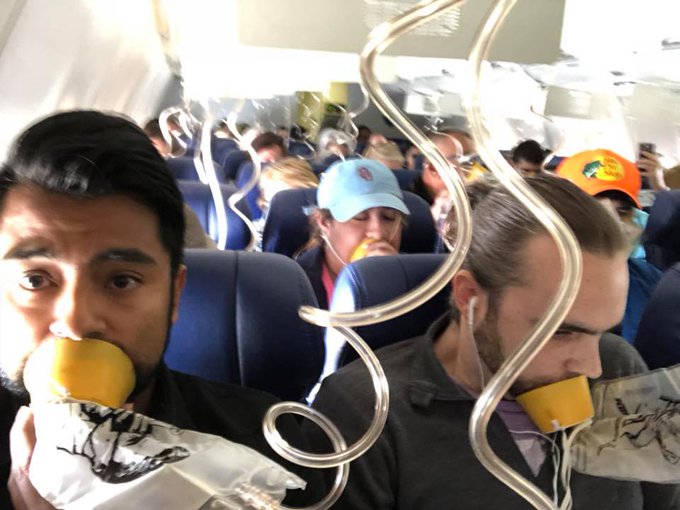Jennifer Riordan, a New Mexico mother and public relations executive known for her loving personality and relentless volunteer work, was identified as the passenger who died on Southwest Flight 1380 after tragedy struck when an engine exploded and blew out a window.
Autopsy results showed the woman died of blunt force impact trauma to the head, neck and torso, NBC 10 reported. The death was ruled as accidental.
It was previously reported by different media outlets that she may have died from a heart attack, which has since been ruled out.
Riordan was remembered as a dedicated volunteer, a mentor, a woman who lived for her family, and as a “treasure of our community.”
The victim, of Albuquerque, New Mexico, was pulled back into the plane by terrified and heroic passengers who tried desperately to save her life.
43-year-old Riordan was a married mother of two children, and served as vice president of community relations at Wells Fargo in Albuquerque. She managed the volunteer services of more than 1,000 employees since 2008, according to her LinkedIn profile.
She died at a Philadelphia hospital after the plane made an emergency landing, authorities said.
“Today, Albuquerque lost a thoughtful leader who has long been part of the fabric of our community,” Albuquerque Mayor Tim Keller posted to Facebook. “We are asking that everyone respect the privacy of the family at this time. This is a tremendous and tragic loss for Jennifer’s family and many others throughout our city. Her leadership and philanthropic efforts made this a better place every day and she will be terribly missed. We are holding Jennifer and her family in our thoughts and prayers.”
A preliminary investigation of that engine which exploded on the flight as it soared 32,000 feet in the air showed evidence of “metal fatigue,” the National Transportation Safety Board (NTSB) reported.
The flight was bound to Dallas from New York’s LaGuardia airport on a twin-engine Boeing 737. Riordan was killed due to debris from a failed engine that smashed open a window.
NTSB Chairman Robert Sumwalt gave his first media briefing, which you can watch above, regarding the incident the evening of the tragedy. He stated, in part:
NTSB investigators arrived in Philadelphia at about 4:30 this afternoon to begin our investigation of the engine failure and fatality of an onboard passenger on Southwest Flight 1380. We deal with a lot of things like this and it’s never easy, and we want to offer our sincerest condolences to the family and friends of the woman whose life was lost today, and also we recognize the passengers and crew onboard that airplane have gone through a lot as well, and we’d like to offer our thoughts and prayers to all of those.
We’ve brought a team of specialists with specialty in power plants, airworthiness to look at the airworthiness of the aircraft itself, power plants will of course be looking at the engine. We have specialists in survival factors operations, and in Washington we have our recorders experts as well as folks that will be looking at the maintenance records of this particular airplane.
Here’s the factual information that we have at this time:
Southwest Flight 1380, a Boeing 737-700 departed LuGuardia at 10:43 a.m. destined for Dallas Love Field. The flight up to the point of the engine failure was routine. Approximately 20 minutes after takeoff as the aircraft was passing through approximately 32,500 feet, multiple aural alerts and warnings sounded in the cockpit. The crew donned their oxygen masks and they reported to air traffic control they had a number one engine fire and they were operating single engine and they were initiating an emergency decent. They requested vectors to the nearest suitable airport and were promptly vectored, cleared directly to the Philadelphia National Airport…now at about the same location as the event unfolded, later someone found a Southwest Airlines engine cowling at Burnville, Pennsylvania.
Our specialists immediately focused on a missing fan blade. So of course as you look in the engine from the front of the airplane there are 24 fan blades that of course normally rotate, and they help bring air into the engine. One of the fan blades, the number 13 fan blade was separated and missing. And it was separated at the point where it would come into the hub. So there’s a hub and then the fan blades attach to the hub. So this fan blade was broken right at the hub, and our preliminary examination of this was that there’s evidence of metal fatigue where the fan separated.
We located that immediately and sent photos to our materials in Washington. And so that is what the preliminary exam has found. There’s much more to be done on this.
“NTSB photo of a piece of the engine cowling from @SouthwestAir #flight1380,” @NTSB_Newsroom tweeted. “Thanks to the general public, these and other parts have been found. Anyone who has found additional pieces please contact witness@ntsb.gov.”
Read on about Tammie Jo Shults, the pilot being hailed as a hero who bravely flew the flight to safety:





